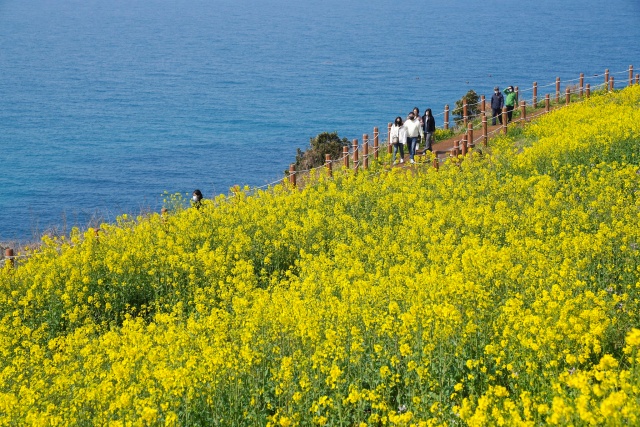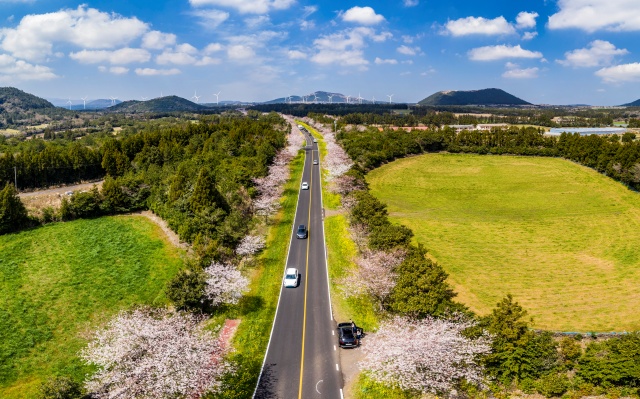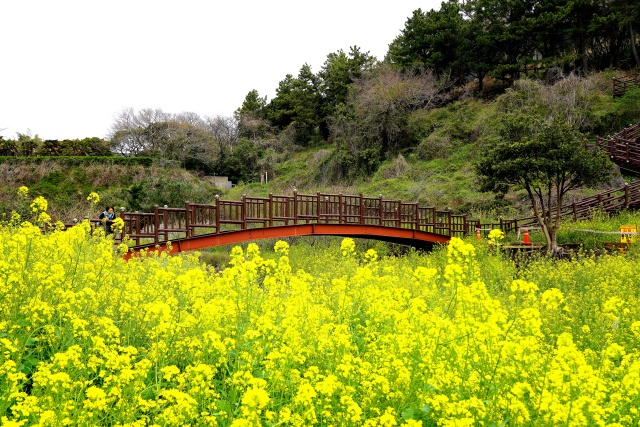Three years have passed already since we began to wear masks for this unexpectedly long period. No one could have imagined that the free exchange of global tourists would come to such a sudden end. In the meanwhile, Jeju has become a beloved destination where domestic tourists could still continue to visit freely.
It became an island of healing for those who were exhausted from COVID-19 and yearning for travel. The spread of the pandemic may be reaching another peak at an alarming rate, but the seasons change nonetheless and flowers have begun to blossom in Jeju once more. Perhaps the flower that most aptly represents Jeju is the canola flower. When the gentle spring breeze blows underneath the blue sky to create waves of yellow among the flowers, the entirety of Jeju is filled with the joyful energy that befits the canola flower’s symbolism. Canola flower buds wave cheerfully in every corner of Jeju. This article introduces destinations in Jeju where one can see beautiful arrays of canola flowers.
Seoubong Peak: A harmony of the jade ocean and canola flowers
 |
||
| ▲ Seoubong Peak | ||
The Seoubong Peak area in Hamdeok-ri, Jocheon-eup, Jeju-si in the east of the island consists of a beautiful village where the jade-green sea perfectly complements the golden canola flowers. Rising tall next to the sea, Seoubong Peak is covered in canola flowers across its steep sides each spring. It is a part of the Jocheon-Gimnyeong Olle Trail, the No. 19 trail on the Olle Trail, and bears the sweat and hard work of Hamdeok-ri residents who toiled for over two years with sickles and hoes to form a walking trail of 2.5km. Their efforts made the trail much easier to navigate, leading visitors to the precious view where the yellow field of canola flowers touches the blue sea.
Noksan-ro Canola Flower Road: Jeju’s finest springtime view
 |
||
| ▲ Noksan-ro Canola Flower Road | ||
The Noksan-ro Canola Flower Road in Gasi-ri, Pyoseon-myeon, Seogwipo-si is a two-lane road that extends around 10km from the Gasi-ri village entrance. Living up to the name of Gasi-ri, which means “a village that extends time,” Noksan-ro is a road that makes drivers want to drive for as long as possible and famously became selected for “Korea’s 100 Most Beautiful Roads.” Around Noksan-ro, the curves of the surrounding oreums such as Ttarabi Oreum and Big Deer Oreum rise above the wide-open canola fields, as if the road is home to all of Jeju’s canola flowers. Towards the end of March, the canola flowers on both sides of the road blossom in unison with cherry blossoms, creating Jeju’s finest springtime view as the two flowers meet.
Eongdeongmul Valley: A scene straight out of Monet’s paintings
 |
||
| ▲ Eongdeongmul Valley | ||
Eongdeongmul Valley in Saekdal-dong, Seogwipo-si has recently risen as one of the most popular spots to enjoy canola flowers. The name “Eongdeongmul Valley” has a rather amusing origin, as “eongdeongi” means “buttocks” in Korean. It was named so because not even wild animals dared to descend down to the valley’s water due to its rough terrain and instead turned their buttocks towards it to answer nature’s call. The spread of canola flowers that stream across the bends of the valley set a dramatic view, while the arched bridge over the flower-covered valley is reminiscent of Monet’s water lily paintings. Eongdeongmul Valley is a part of Jeju Olle Trail Route 8 and links with Lotte Olle Trail in Jungmun Tourism Complex, which can be ascended up a stairway for a stunning view.
Jeju Weekly editor@jejuweekly.net






